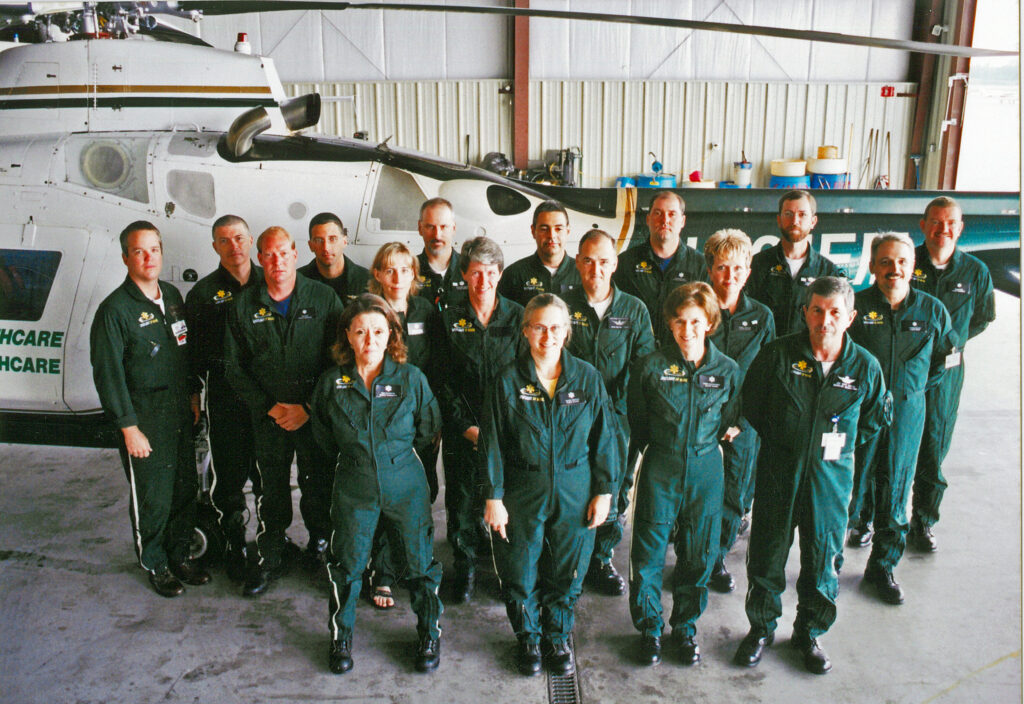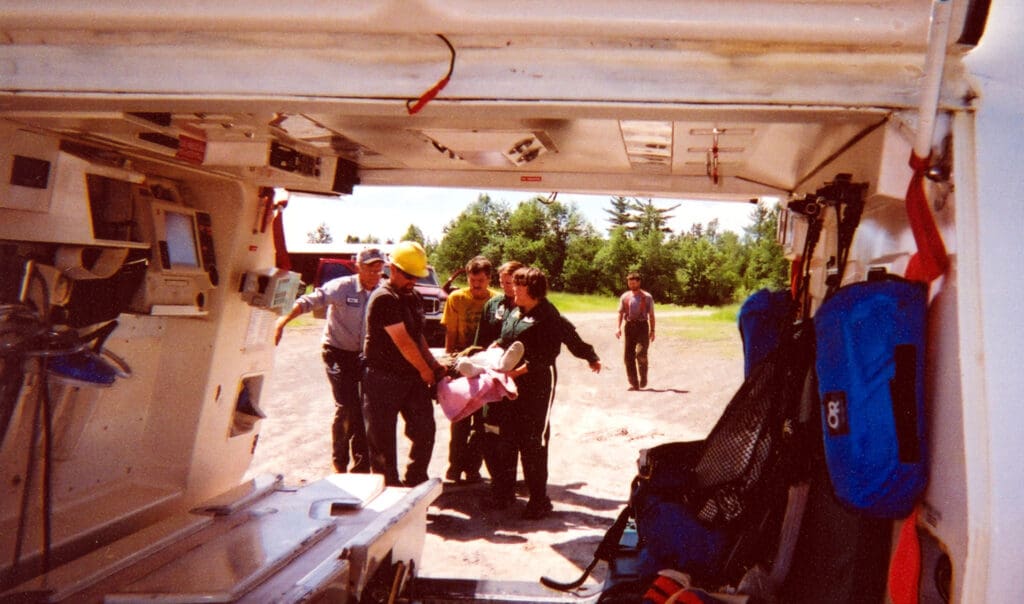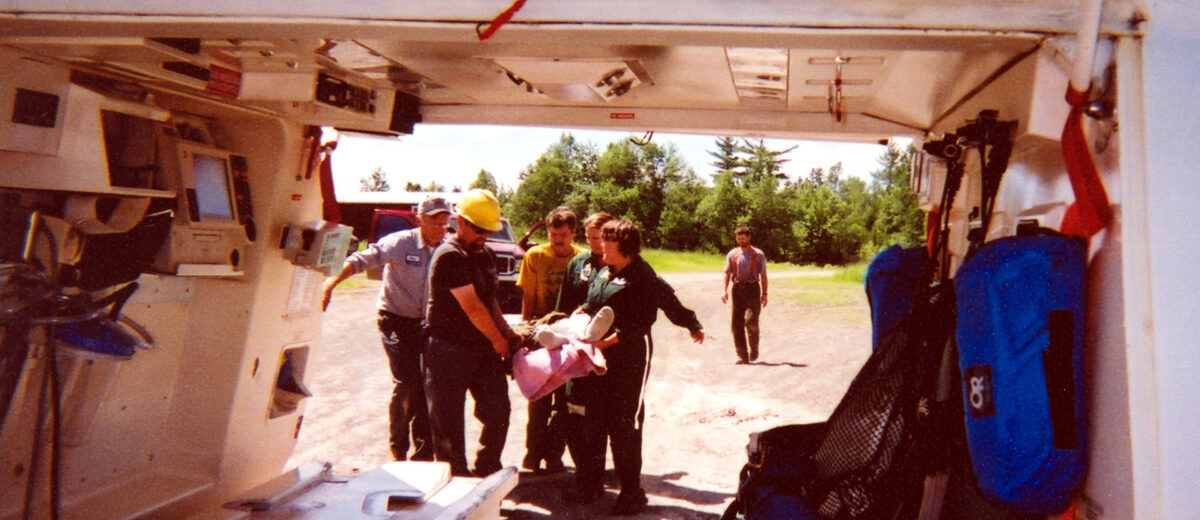Treat Everyone like Your Mother: 25 Years from the Crew’s Perspective

by Henry Frank
This article appeared in the October 2023 issue of Dispatches.
The expression “building the plane while flying it” does not quite work, because it was a helicopter.
In 1998, Maine was the last state in the country to implement an air medical system. “We literally had nothing,” Sandy Benton said only somewhat facetiously of LifeFlight’s early days. Sandy worked as a flight nurse and manager of LifeFlight 1 in Bangor for 18 years. “We were writing protocols and guidelines on paper, and then we would find someone somewhere who could type them up.” Sandy was there from the beginning — before the beginning, in fact. She began working with Tom Judge, one of LifeFlight’s founders and long-time executive director, to develop a ground critical care team in 1996, two years before LifeFlight began operations in September 1998.
“We went into this adventure with blind faith in Tom,” said Lori Metayer, who worked as a flight nurse and manager of LifeFlight 2 in Lewiston for 24 years. This small team of experienced nurses, paramedics, and pilots were embarking on something new. It was not only new to them and new to Maine, but with an innovative spirit and a penchant for excellence, the nonprofit air medical service they were building was unlike any other program in the country.
It took time to build, and the team proceeded purposefully, thoughtfully, and ambitiously.
“In the early days, we had two calls in a week,” said Lori. “The average crew would have about 1,000 hours of briefing time and clinical duties in the hospital, with only about 40 hours of flight time, and half of those flight hours were with a patient,” said Dave Burr, who recently retired as Director of Operations for LifeFlight Aviation Services and worked as a rotor wing pilot for LifeFlight since 2000. “In a six- day period, we would maybe fly two or three times.” Today, LifeFlight transports a patient on average every 3.5 hours.
The medical crew had not spent much time in a helicopter, and pilots like Dave, who flew helicopters in the US Navy and then the agriculture industry, had not spent much time flying with a critically ill or injured patient in the back. “The beginning was as challenging as it was novel, because you had three very Type A disciplines in a tight space,” Dave said. “We learned really quickly.”
LifeFlight helicopters have always flown with a crew of one pilot, one nurse, and one paramedic. (The helicopters have advanced avionics and can be operated by a single pilot. LifeFlight’s fixed wing airplane is flown by a pilot and a first officer.) The LifeFlight nurses are required to have intensive care unit (ICU) experience, which is essential training for the ICU-level care provided by LifeFlight during transport. The paramedics, also with critical care training, have experience in the back of ambulances. While different disciplines, nurses and paramedics on LifeFlight’s crews work together in unison using the same protocols and standing orders. The pairing is vitally important to LifeFlight’s patients, but in 1998 everyone had to get used to this novel arrangement.
“When the LifeFlight crew came into that ER, the people stepped aside. LifeFlight has brought advanced medical care to areas that would have never been able to afford it.”
– Miles Theeman, former president of Affiliated Healthcare Systems and LifeFlight of Maine Steering Committee member
“We had to show the state, and particularly Maine EMS, that we were worth it, and that we were making a difference in the lives of patients,” said Sandy. “Our goal was to become the people in green, not ‘nurse’ or ‘paramedic.’”
The pilots had to adapt their mindset as well, and it did not take them long. “When you think about how capable and smart the nurses and medics are, it would be a mistake not to utilize that,” said Dave. “As aviators and pilots, we would ask the medical crew to help us think things through to ensure the safest possible outcome. We’re all in this together. We all had to learn to manage our risks. We quickly learned to ask everyone on the team: ‘What are you going to do to contribute to the safety of the operation today?’”
In 2017, the Federal Aviation Administration (FAA) instituted training and aviation safety requirements for helicopter air medical crews. “All the training requirements that the FAA specified within that rule, LifeFlight of Maine had been doing formally since at least 2003, and informally before that,” said Dave.

Lori, Sandy, Tom, Dave, and the rest of the team in the early days built what is now an internationally renowned nonprofit air medical service, transporting more than 37,000 patients over the past 25 years. They also built a culture of excellence within the organization. “We built the protocols for this program off the national standards for excellence,” said Lori. “That’s what Tom and Sandy used as a guide for the development of the program. We became certified [by the Commission on Accreditation of Medical Transport Systems (CAMTS)] within 5 years, and that was unheard of.”
“Tom had three rules: treat everybody like your mother, be all you can be, and feel free to think,” said Sandy. “There are so many areas in Maine that have limited resources, even more so than when we started. LifeFlight brings those resources to people. We worked every day to improve ourselves and our teammates that we were with. We’re here for the citizens of Maine.”
The culture of excellence at LifeFlight is palpable in every single crew member. It is their dedication to their colleagues and to their patients that sets them apart. “I still love LifeFlight,” said Lori. “My kids grew up with it. Sandy’s kids grew up with it. But it’s a young person’s job. Twenty-four years of it was all my body could take.” Lori retired from LifeFlight of Maine in 2022. When asked about what she thinks the future holds, Lori said: “Nothing is off the table for the future of LifeFlight. The key is to get to the people who need us in any way that we can.”
Henry Frank is the director of communications for LifeFlight of Maine.

